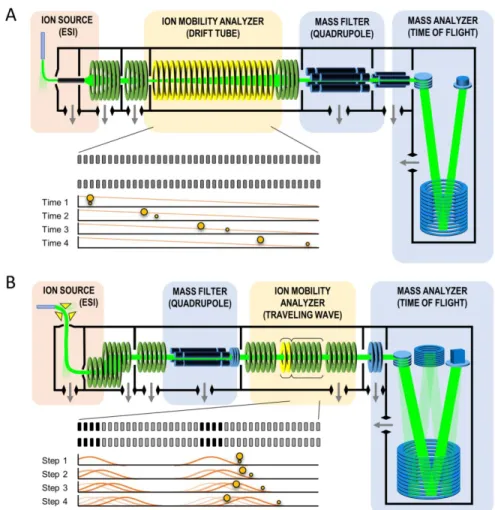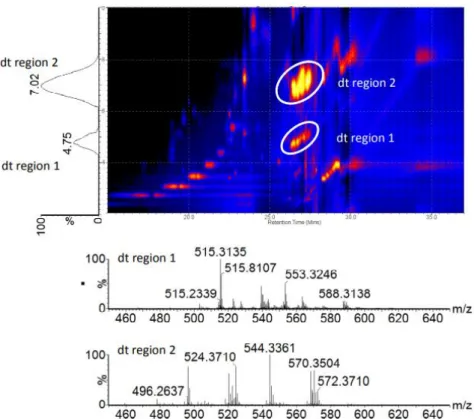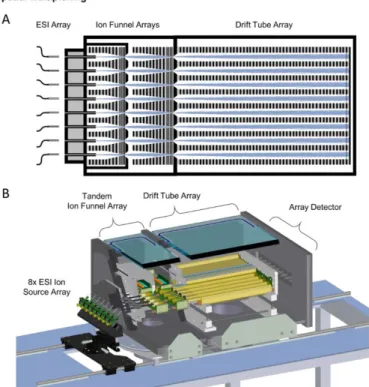Thank you for the opportunities you have given me to learn and grow as a scientist and teacher. Dad, you always used the opportunity to impart wisdom, and the example you were continues to challenge me.
Statement of Thesis
Trends in IM that can be used for characterization of unknowns will be shown, along with the effect of drift gas on class separation. A study covering a wide range of drift gases, masses, classes, mobilities and charge states will be presented to investigate the effect of drift gas on CCS separation.
Origins of Biomolecular Analysis by Ion Mobility-Mass Spectrometry
Note that the scale is truncated at 300 to highlight the number of publications specifically using IM-MS. Other MS vendors have entered the market with their own commercial IM-MS offerings, including Agilent Technologies in 2014 (drive tube IM) and Bruker Corporation in 2016 (trapped IM).
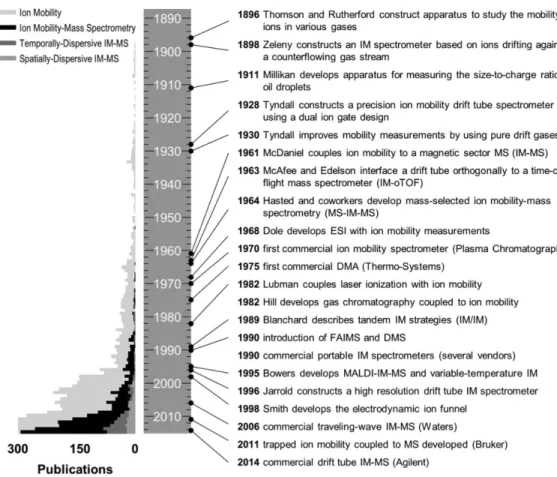
Biomolecular Separation and Analytical Utility of IM-MS
Lipids exhibit a characteristic behavior in IM-MS that is indicative of the identity of the head group.27 The efficiency of lipid packing is influenced by the head group and the unsaturation within the acyl tail(s), forming different trend lines in gas phase maps -collision cross-section (CCS) versus mass. Isobaric compounds that are insoluble by conventional MS can be distinguished in the IM dimension due to the different conformations they adopt, whether they are peptides, carbohydrates or lipids.42-47 Collectively, the ability to rapidly dissolve biochemical species on basis of both structure and mass differences made IM-MS an invaluable analytical tool for biomolecular analysis.
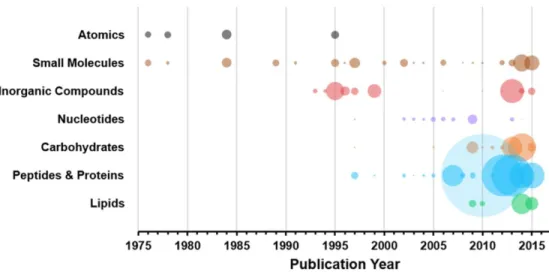
Instrumentation Considerations
- Chromatography
- Ion Sources
- Time-Dispersive Ion Mobility Techniques
- Mass Spectrometry Considerations
This leads to reproducible fragmentation of ions and the analysis of CID fragmentation spectra was used with IM-MS to identify isobaric species exhibiting different binding energies. The next few sections discuss some of the applications of IM-MS to biomolecular analysis in more detail.
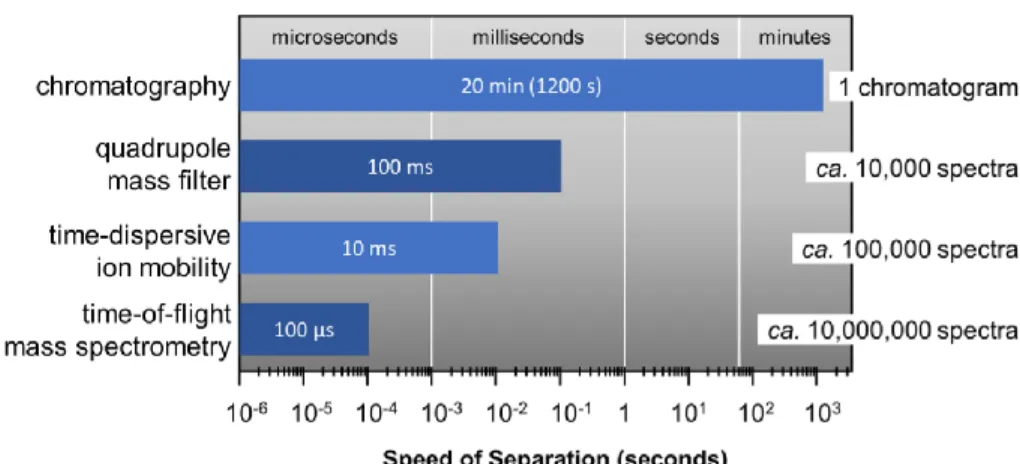
Introduction to Current Trends
It can be used to identify isobaric species or as an additional descriptor for the identification of unknowns. As shown in Figure 1.6, gas chromatography, liquid chromatography, or another front-end separation can easily be combined with ion mobility and mass spectrometry analysis to provide high-dimensional data sets that can be partitioned into specific ohmic workflows.62 The ion mobility provides a chemical class -specific separations based on differences in intrinsic gas-phase packing, as well as quantitative size information via the CCS measurement that can be used as a reproducible measurement for identification purposes.62.
Integrating Ion Mobility for Omic Analysis
Proteomics
Common separation methods for proteomics include gel electrophoresis, liquid chromatography and, in a growing number of cases, ion mobility67-69. Ion mobility has been used extensively in structural proteomics.60,70 Proteins of similar or exact mass, such as protein conformers, can be separated by ion mobility due to differences in their gas phase sizes.
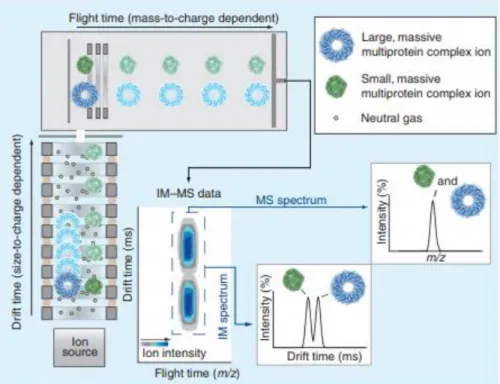
Lipidomics
In addition to protein separation, ion mobility is used to probe structural information.70 Temperature-controlled ESI sources and heated ion transfer capillaries have been used prior to IM-MS to rapidly heat proteins and monitor their denaturation. controlled.72-74 In addition. Thermally induced protein conformational transformations as well as protein-ligand interactions can be observed. Ion mobility allows the differentiation of certain geometric isomers of lipids, such as cis versus trans, even when in a complex biological mixture.
Metabolomics
As demonstrated by Paglia et al., ion mobility can be used to align fragmentation spectra with precursor parent ions to increase confidence in lipid identification (Figure 1.8). with the same m/z ratios. By using ion mobility prior to fragmentation, co-eluting small molecules can be further resolved after chromatography.
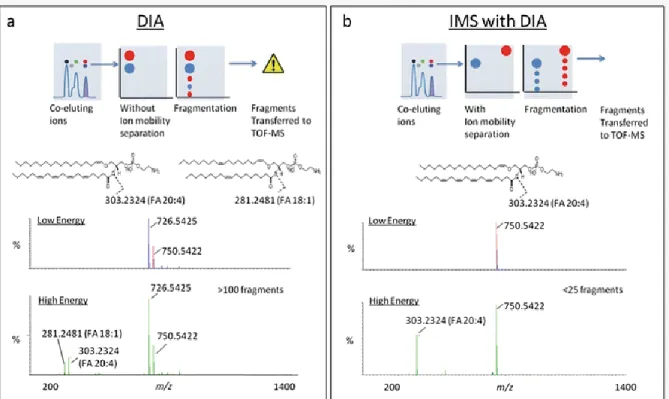
Continuing Advancements in IM-MS Technology
An example of SLIM-based ion mobility instruments is shown in Figure 1.10.102 Current designs have created instruments with some of the highest IM resolutions currently available.54, 103. It is common to change the drift gas in some high- field IM techniques, such as high-field asymmetric waveform ion mobility spectrometry (FAIMS) and differential mobility spectrometry (DMS).114-119 This is less common with low-field IM techniques, but there have been a number of significant examples.120-121 .
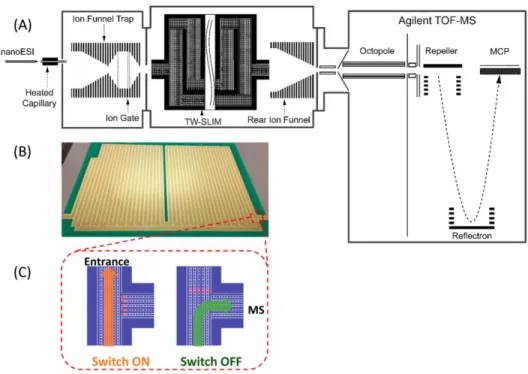
Combining Discrete Omic Databases for Multi-Omic Experiments
Throughout this chapter, the use of the idea of using collisional cross-section as a tool for separation and descriptor for biomolecules has been addressed. However, this can only be useful to the field if there is a database containing accurate collision cross sections.
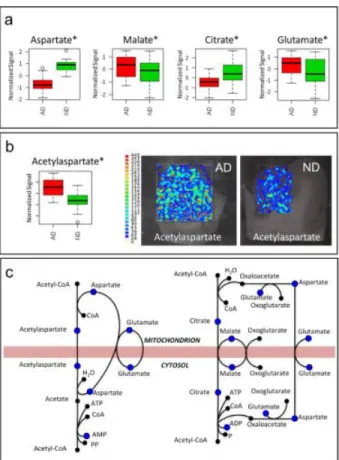
Statement of Dissertation
I created figures to demonstrate the reasoning behind the instrument parameter recommendations, as well as creating figures demonstrating the effects of drift gas on CCS. This work also provides recommendations for drift gas selection and assists researchers in identifying the appropriate drift gas for their analytical application.
Acknowledgements
An analysis of the composition of the CCS values published from 1975 to 2015 is presented in Figure 2.3 for a few selected categories. This is shown in Figure 5.6(a), where the selected ions studied are plotted as a function of propellant polarizability.
An Ion Mobility Collision Cross Section Compendium
Introduction
Ion mobility is generally used in one of three ways by researchers (Table 2.1): (1) as an additional resolution dimension to increase peak capacity and separate chemical noise from analyte signals of interest, (2) as a measure of adjunct to analyte identification and characterization, and/or (3) as a structural measurement technique, where ion mobility information is used to extract some detail about the structure (either primary or higher order) of the analyte. The last two strategies, analyte identification and structural measurement, are achieved by converting the ion mobility measurement (usually the displacement time) into a value of the ion-neutral collision cross section, which represents a fundamental property of the analyte being compared. in different laboratories.
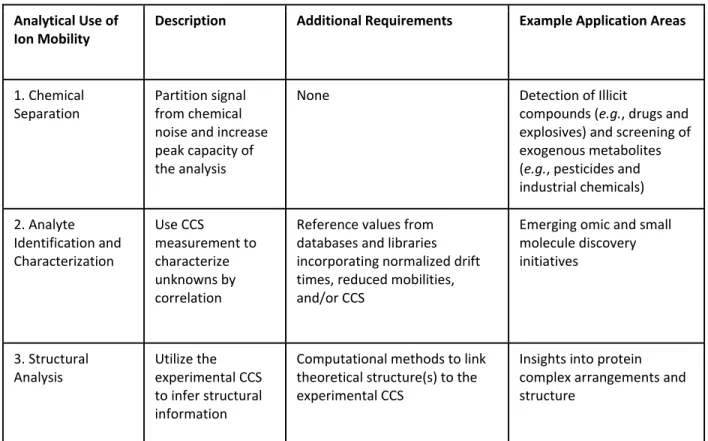
The Collision Cross Section
It should be noted here that accuracy and precision are important distinctions, as very reproducible CCS values can now be obtained (better than 2%),2,41 but their accuracy cannot be validated without comparing the ion mobility results with CCS measurements obtained from other techniques, which are currently still in development.42-44 Despite these standing questions regarding the accuracy and significance of the CCS, it is clear that there is immense value in having a standardized fundamental property of an analyte to report in the form of a CCS that is both highly reproducible and now readily accessible by a large number of researchers. Given the often ambiguous nature of the experimental context in which CCS values are reported, the nomenclature formalized in Table 2.2 is recommended for future use in the field.

Significant CCS Contributions
The carrier gas used in the measurement or calibration is specified for each year. B) Laboratories and studies that contributed significantly in terms of the number of reported values. In fact, there are only three individual studies that have reported more than 1000 CCS values and would therefore be considered large-scale studies,54,55,72 highlighting the fact that the reporting of quantitative measurements of ion mobility is predominantly an interlaboratory initiative.
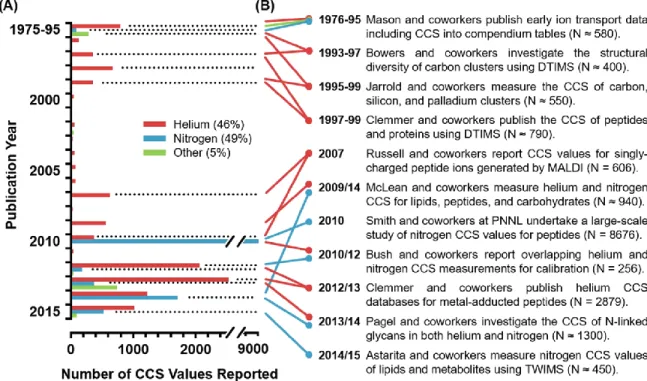
Drift Gases Represented
While only major studies are highlighted here, the majority of contributions to the CCS canon (75%) have come from smaller studies reporting 50 or fewer CCS values (Figure 2.2). The sparse amount of CCS data reported for gases other than helium and nitrogen is largely a combined result of both technical challenges with operating under different propellant gas conditions (instrument tuning, pressure gauge calibration issues and the uncertainty with the calculation of CCS from measured displacement times), as well as fundamental difficulties with interpreting the structural meaning of CCS values obtained using gases other than helium.
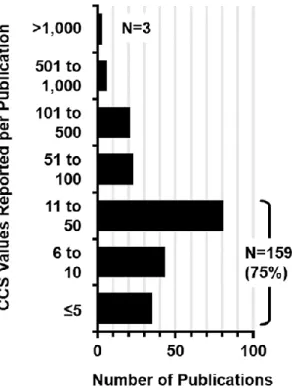
Composition of Measurements
Most of the anion CCS values reported are from two recent carbohydrate studies, one on chemically released glycans and corresponding ion fragments generated in the source,67 and another that reported negative ion CCS values on dextran and pullulan -oligosaccharides report.122 Remaining anion contributions represent the classic DTIMS studies on atomic and molecular clusters,57,63,123 and recent negative ion measurements for proteins,124 lipids,1,71 and metabolites.70,125 The primary ionization method used in the quantitative measurement of the CCS is ESI (87%, not shown) which tends to produce predominantly +2 ions for tryptic peptides.126 Since tryptic peptides represent the majority of CCS measurements reported in the literature (vide infra), it is no surprise that there are more +2 ions than any other charge state. The focus on peptide and protein work can be rationalized as a result of continued efforts to adapt ion mobility technologies to proteomics workflows,127-129 but also a practical consequence of both the ease of generating large pools of peptides derived from enzymatic digestion130 and the fact that the structural and charge-state heterogeneity of proteins necessitates the reporting of many CCS values for a single protein.
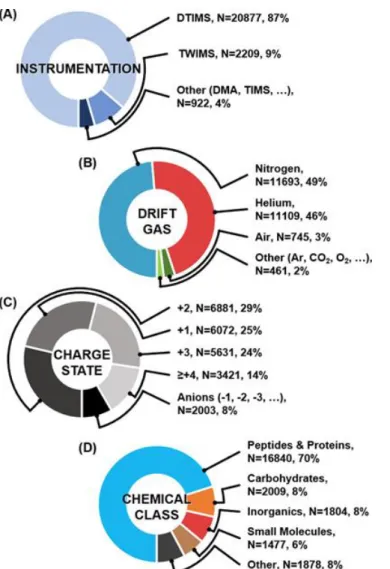
Chemical Space Represented by IM-MS Analysis
A 3-dimensional surface plot illustrating regions of highest density in terms of number of CCS values. The overall conformational ordering of biomolecules observed here correlates qualitatively with gas-phase structural trends observed by previous studies, namely, lipids adopt more extended gas-phase structures than peptides and carbohydrates. 2,135,136 The quantitative differences observed between helium and nitrogen are due to the estimation of CCS values corresponding to different analytes in each figure.
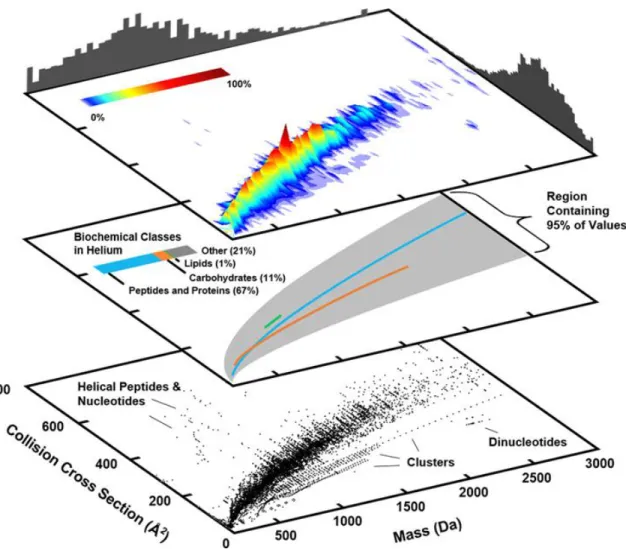
CCS Coverage over Time
The bubble chart projection in Figure 2.7 compares the number of CCS values reported over time for specific analyte classes and types. A significant number of peptide and protein CCS values reappeared in the literature in 2007.
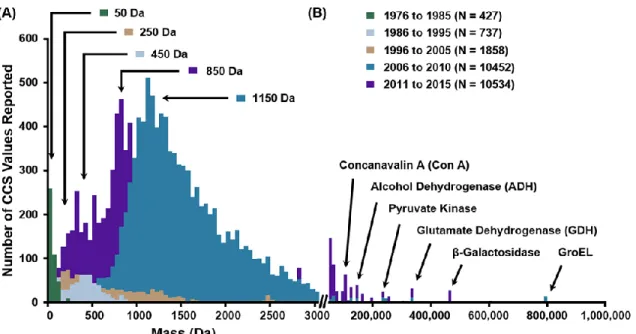
Concluding Remarks
Given the rapid growth now seen in the field of quantitative ion mobility, many of the analytical prospects described in this review are likely to be realized within the next few years.
Acknowledgements
Specifically, low ion introduction voltages (≤5V) gave high CCS values, whereas the high ion introduction voltages (≥15V) resulted in low CCS values regardless of the propellant identity. Note that the CCS of carbohydrates (orange squares) relative to the other compounds exhibits a strong dependence on the identity of the propellant used.
Untargeted Molecular Discovery in Primary Metabolism: Collision Cross Section as a
Introduction
Because biological function follows molecular structure, characterization of isomeric species is imperative for complete molecular identification and accurate pathway analysis. METLIN, HMDB, etc.)18 include multiple descriptors of analyte information (e.g., accurate mass, ion adduct form, fragmentation pattern, and retention time) to increase confidence in molecular identification.19 With the advent of commercially available ion mobility mass spectrometers in 2006,20 Collision Cross Section (CCS) has become an additional molecular descriptor for untargeted experiments.
Experimental Methods
- MSMLS Sample Preparation
- Collision Cross Section Measurements
- IM-MS Source and Drift Cell Conditions
- Nonlinear Regression Analysis
- Human Serum Preparation
- Liquid Chromatography
The dried fractions were resuspended in 200 µL of the initial mobile phase solvent and analyzed via LC-IM-MS. LC-IM-MS was performed on NIST 1950 prepared serum using HILIC chromatography for the hydrophilic liquid-liquid extraction layer.
Results and Discussion
- MSMLS Plate Coverage
- Mass-Mobility Correlation Analysis
- Metabolic Pathway Coverage
- Isomers in Metabolomics
- IM-MS Separation in Primary Metabolites
- LC-IM-MS Characterization of NIST 1950 Serum
Specifically, each nucleoside isomer has a distinct cross-sectional distribution that is distinguishable in the protonated [M+H]+ and sodium adducted [M+Na]+ species, but the rearrangement of the phosphate group between A-5-DP and A- 3, 5-DP provides no resolution for the deprotonated form observed in negative ion mode [M-H]-. After sorting all observed isomer sets in the MSMLS data set, pairwise matches were created and evaluated based on their percent difference in CCS.
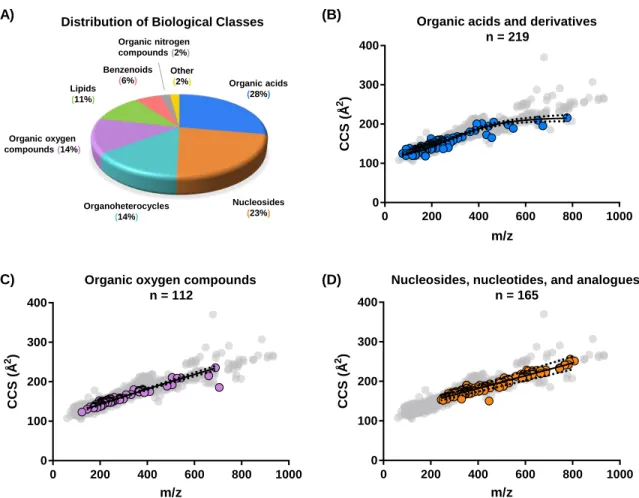
Conclusions
Acknowledgements
Selection of propellant in future studies should consider propellant mass and polarizability. Evaluation of separation selectivity and measurement of collision cross section reproducibility in helium, nitrogen, argon, and carbon dioxide drift gases for drift tube ion mobility mass spectrometry,” Journal of the American Society for Mass Spectrometry 2019 (in press).
Conformational Ordering of Biomolecules in the Gas Phase: Nitrogen Collision Cross-Sections
Introduction
The most common commercial IM-MS platform uses an electrodynamic field (i.e., traveling wave potential) to separate mobilities,8 and drift time measurements must be calibrated against electrostatic drift tube data to convert these measurements to CCS values.9,10 In contrast, many independently constructed instruments include uniform regions of electrostatic field mobility using helium as a buffer gas. A prototype IM-MS instrument using nitrogen drift gas (Agilent Technologies, Santa Clara, CA) has recently been developed.
Experimental Methods
- Preparation of Standards
- Lipids
- Carbohydrates
- Peptides
- Quaternary Ammonium Salts
- Instrumentation
- Experimental Parameters
- Collision Cross-Section Calculations
A schematic of the instrumentation used to obtain cross-sectional measurements is shown in Figure 4.1. Uncorrected drift times are extracted as central values using a beta version of the IM-MS browser (Agilent Technologies).
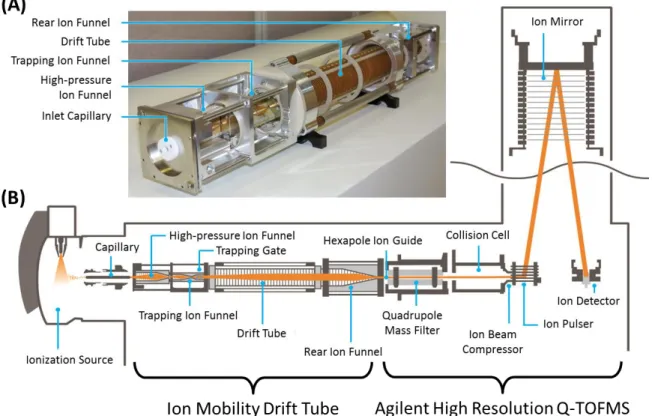
Results and Discussion
- Database Description and General Cross-Section Trends in Nitrogen
- Description of the Fits to the Empirical Data
- Extraction of Sub-Trend Information from the Data
- Comparisons between Helium and Nitrogen CCS Values
Data inclusion bands plotted in Figure 4.2(B) representing ±5% deviation from the line of best fit. A scatterplot of the relative location of carbohydrate subclasses in 2D IM-MS conformational space.
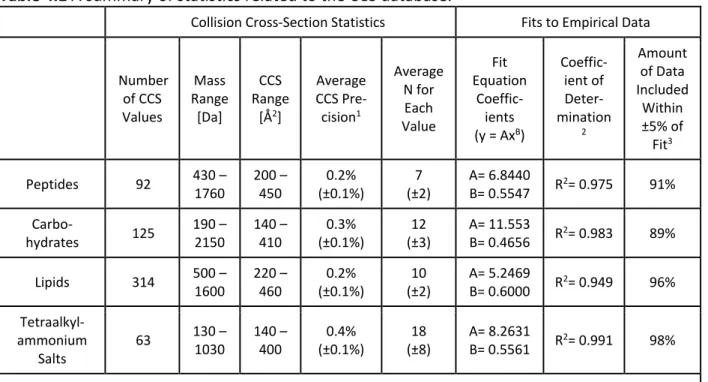
Conclusions
In other words, the stronger nitrogen interaction potential would be expected to scale with the number of atoms in the ionic system being measured, at least to a first approximation. In contrast, lipids exhibit the largest CCS values among the investigated biomolecules, and this observation appears to be intrinsic to the inability of lipids to form compact, self-dissolved structures in the gas phase.
Acknowledgements
The pressure conditions in the ion transfer funnels before the drift tube were systematically investigated for each propellant to determine the effect on the measured CCS. 𝐶𝐶𝑆 = 𝜋(𝑟𝑚𝑜𝑙𝑒𝑐𝑢𝑙𝑒+ 𝑟𝑔𝑎𝑠)2 (6.1) where the radius is the sum of the molecule and the propellant gas.
Evaluating Separation Selectivity and Collision Cross Section Measurement Reproducibility
Introduction
In a conventional drift tube, the separation of chemical species is the result of numerous, almost thermal, collisions between analyte ions and a chemically inert drift gas. Recently, Yost and co-workers demonstrated increased resolving power for several isobaric steroids analyzed in a reduced pressure drift tube instrument using CO2 as the drift gas 27 .
Methods
- Instrumentation
- Variable Pressure Experiments
- Effective Length
- Chemical Standards
Previous research with He drift gas showed that the operating pressures of the HPF and TF had an effect on the measured CCS, presumably due to changes in gas purity within the DT 35. Operational limits of the flow controller (calibrated for N2) limited helium experiments up to a maximum of 4.63 Torr in the HPF with 3.80 Torr in the TF.
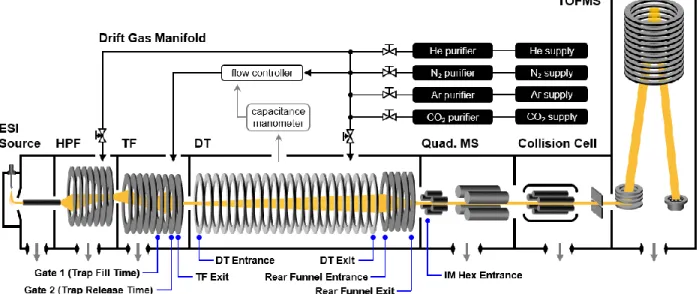
Results and Discussion
- Analyte Selection
- Pressure Effects
- Ion Source Temperature Effects
- Ion Injection Potential
- CCS Measurements
- Chemical Class Behavior
- Drift Gas Selection Criteria
McLean, "Evaluating Separation Selectivity and Collision Cross Section Measurement Reproducibility in Helium, Nitrogen, Argon, and Carbon Dioxide Drift Gases for Drift Tube Ion Mobility-Mass Spectrometry," Journal of the American Society for Mass Spectrometry 2019 (in press). Evaluation of separation selectivity and measurement of collision cross section reproducibility in helium, nitrogen, argon, and carbon dioxide drift gases for drift tube ion mobility mass spectrometry,” Journal of the American Society for Mass Spectrometry 2019 (in press).
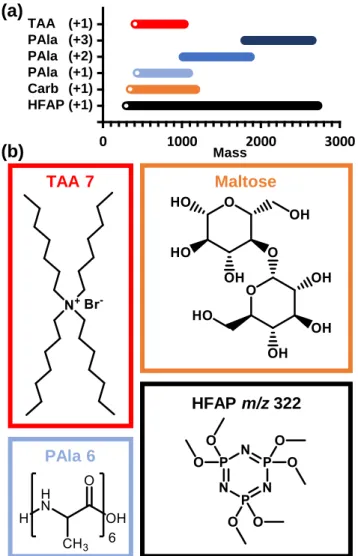
Conclusion
Argon acts similarly to nitrogen, but may be chosen over nitrogen if a slight increase in resolution is required for lower mass analytes. Finally, the highly consistent CCS values measured in this study can be used as a basis for improving the fundamental theory of IM and developing algorithms that take into account the identity of the entrained gas in predicting the elution behavior of IM.
Acknowledgements
Overall, the CCS reference values and recommended experimental parameters described in this manuscript are expected to assist IM researchers in selecting the appropriate drift gas for their analytical problem, as well as provide guidance for incorporating alternative drift gases into the work of next. The views expressed in this document are solely those of the authors and do not necessarily reflect those of the funding agencies and organizations.
Based on this research, recommendations have been made for the selection and use of each drift gas. The magnitude of the effect of drift gas mass and drift gas polarizability across multiple classes, mobilities, analyte masses, and charge states is still unclear.
Conclusion and Future Directions
Conclusion
A large set of different classes spanning a wide range of motions, masses, and states of charge were investigated in these four driving gases. This work presents an important study of propellant gases covering a wide range of classes, mobilities, masses and states of charge to aid future work with propellant gases.
Future Directions
- Mathematical Descriptors in Databases
- CCS Prediction
- Drift Gas Selection
A user would input an unknown's mass, CCS, state of charge, and the propellant used to generate the CCS, and this method would generate a list of CCS values in other propellants in seconds. Note that when the analyte mass reaches zero, the propellant radius is equivalent to its hard sphere radius.
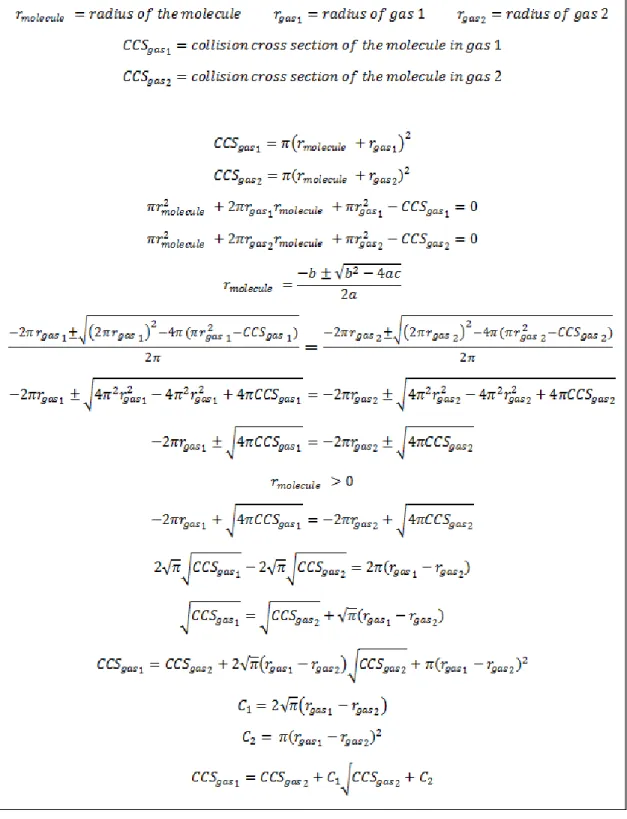
Gas-Phase Conformational Ordering of Biomolecules: Nitrogen Collision Cross Sections Measured in a Prototype High-Resolution Drift Tube Ion Mobility-Mass Spectrometer," Analytical Chemistry. Reduced mobility values are classically reported for ions of small mass and are given in the following tables for convenience.
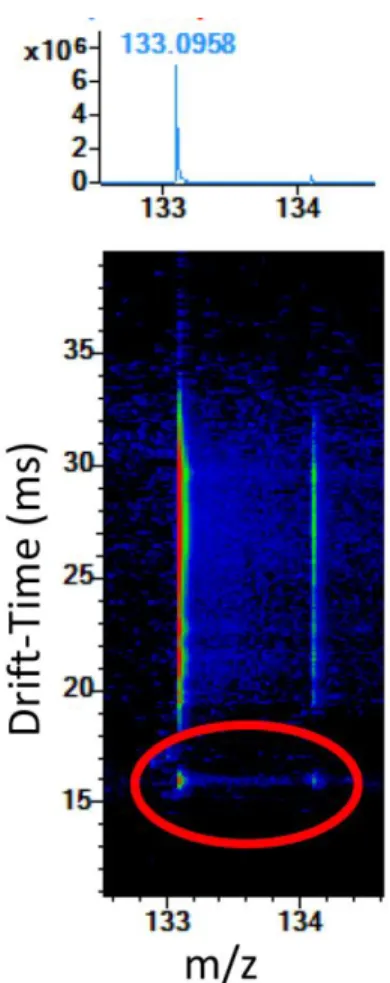
Supplemental Information for Chapter 3
Supplemental Information for Chapter 4
Supplemental Information for Chapter 5
Curriculum Vitae
Three Key Analytical Uses of Ion Mobility
Three Key Analytical Uses of Ion Mobility
Formalized Nomenclature for CCS Reporting
Summary of Statistics Related to the CCS Database
TAA Salts Compared to Literature Values
Historical Developments in Ion Mobility (IM) Technologies
Historical Chemical Class Representation
Molecular Class Trends
Nesting of Analytical Timescales
Temporally-Dispersive Ion Mobility Techniques
IM-MS Analysis Workflow
IM-MS Data Acquisition and Basic Principles
Schematic Visualization of Data Acquisition
Example 2D IM-MS Image
SLIM SUPER IM-MS Instrument Schematic
Spatial Multiplexing
Mitochondrial Shuttles
Number of CCS Values Published in 40-Year Span
Number of CCS Values Reported Per Publication
Composition of CCS Values
Helium-Specific Conformational Space Plot
Nitrogen-Specific Conformational Space Plot
Mass Distribution of CCS Values
Historical Chemical Class Representation
Biological Category Distribution
Metabolite Pathway Coverage
Isomer Separation
Separation Strategy Comparison
NIST 1950 Human Serum Sample
Prototype Instrument Schematic
Scatter Plot of CCS Values
Sub-Class Analysis of Carbohydrates
Sub-Class Analysis of Lipids
Helium and Nitrogen CCS Comparison
Instrument Schematic of an Agilent 6560
Molecular Class Mass Coverage
Cesium CCS Comparison to Literature Values
Drift Gas CCS Plots
Class Drift Time Profiles in Multiple Drift Gases
Class Response and Separation in Multiple Drift Gases
Derivation of an Equation for Drift Gas CCS Relationship
Drift Gas Selection
